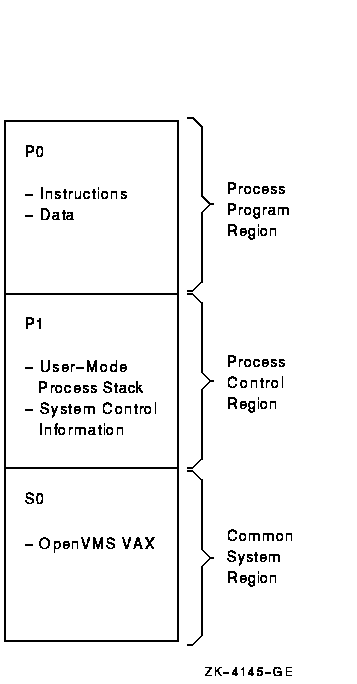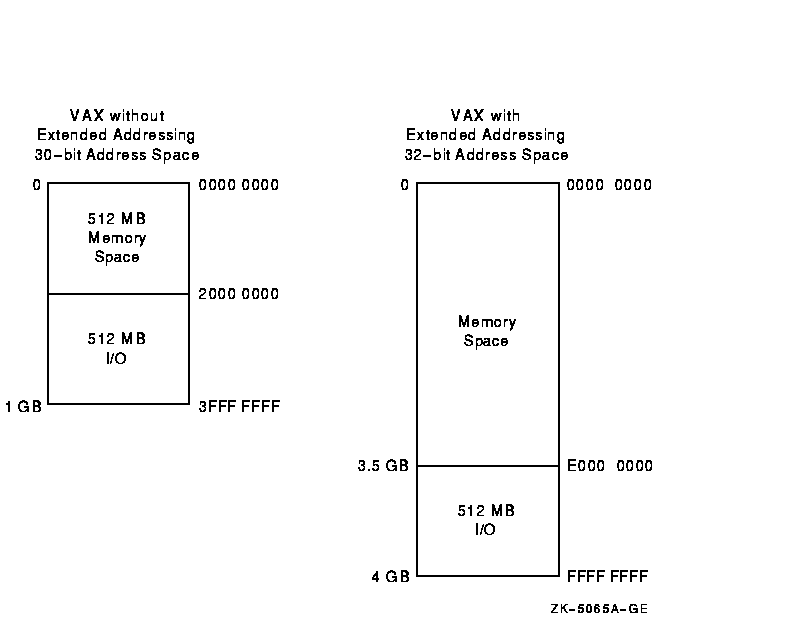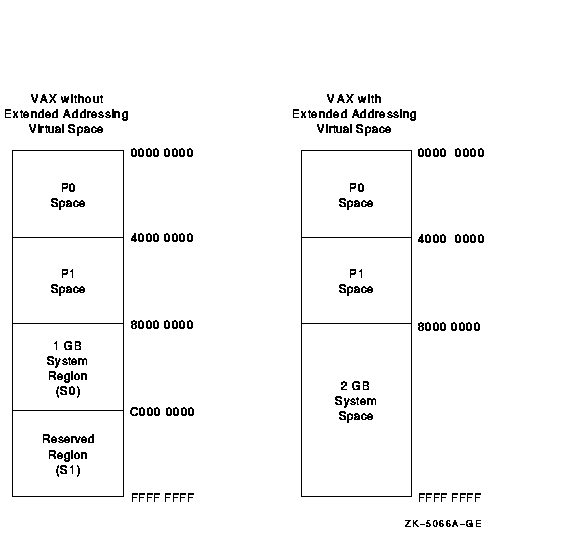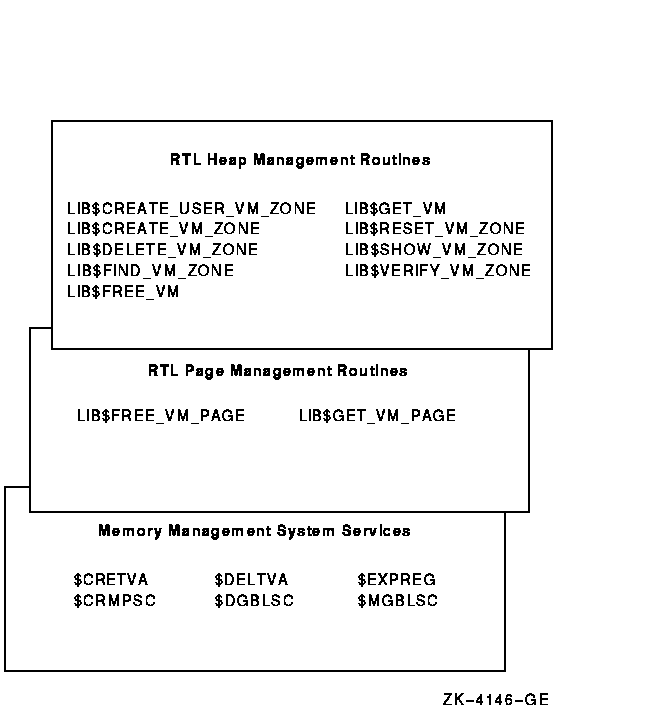 |
HP OpenVMS Programming Concepts Manual
12.3.10 Example of Using 32-Bit Memory Management System Services
In the following example, two programs are communicating through a
global section. The first program creates and maps a global section (by
using SYS$CRMPSC) and then writes a device name to the section. This
program also defines the device terminal and process names and sets the
event flags that synchronize the processes.
The second program maps the section (by using SYS$MGBLSC) and then
reads the device name and the process that allocated the device and any
terminal allocated to that process. This program also writes the
process named to the terminal global section where the process name can
be read by the first program.
The example program uses the SYS$MGBLSC system service. However, the
SYS$MGBLSC_64 system service is the preferred method for mapping global
sections for Alpha and I64 systems.
The common event cluster is used to synchronize access to the global
section. The first program sets REQ_FLAG to indicate that the device
name is in the section. The second program sets INFO_FLAG to indicate
that the process and terminal names are available.
Data in a section must be page aligned. The following is the option
file used at link time that causes the data in the common area named
DATA to be page aligned: PSECT_ATTR = DATA, PAGE
For high-level language usage, use the solitary
attribute of the linker. See the HP OpenVMS Linker Utility Manual for an explanation of
how to use the solitary attribute. The address range
requested for a section must end on a page boundary, so SYS$GETSYI is
used to obtain the system page size.
Before executing the first program, you need to write a user-open
routine that sets the user-open bit (FAB$V_UFO) of the FAB options
longword (FAB$L_FOP). Because the Fortran OPEN statement specifies that
the file is new, you should use $CREATE to open it rather than $OPEN.
No $CONNECT should be issued. The user-open routine reads the channel
number that the file is opened on from the status longword (FAB$L_STV)
and returns that channel number to the main program by using a common
block (CHANNEL in this example).
!This is the program that creates the global section.
! Define global section flags
INCLUDE '($SECDEF)'
! Mask for section flags
INTEGER SEC_MASK
! Logical unit number for section file
INTEGER INFO_LUN
! Channel number for section file
! (returned from useropen routine)
INTEGER SEC_CHAN
COMMON /CHANNEL/ SEC_CHAN
! Length for the section file
INTEGER SEC_LEN
! Data for the section file
CHARACTER*12 DEVICE,
2 PROCESS
CHARACTER*6 TERMINAL
COMMON /DATA/ DEVICE,
2 PROCESS,
2 TERMINAL
! Location of data
INTEGER PASS_ADDR (2),
2 RET_ADDR (2)
! Two common event flags
INTEGER REQUEST_FLAG,
2 INFO_FLAG
DATA REQUEST_FLAG /70/
DATA INFO_FLAG /71/
! Data for SYS$GETSYI
INTEGER PAGE_SIZE
INTEGER*2 BUFF_LEN, ITEM_CODE
INTEGER BUFF_ADDR, LENGTH, TERMINATOR
EXTERNAL SYI$_PAGE_SIZE
COMMON /GETSYI_ITEMLST/ BUFF_LEN,
2 ITEM_CODE,
2 BUFF_ADDR,
2 LENGTH,
2 TERMINATOR
! User-open routines
INTEGER UFO_CREATE
EXTERNAL UFO_CREATE
.
.
.
! Open the section file
STATUS = LIB$GET_LUN (INFO_LUN)
IF (.NOT. STATUS) CALL LIB$SIGNAL(%VAL(STATUS))
SEC_MASK = SEC$M_WRT .OR. SEC$M_DZRO .OR. SEC$M_GBL
! (Last element - first element + size of last element + 511)/512
SEC_LEN = ( (%LOC(TERMINAL) - %LOC(DEVICE) + 6 + 511)/512 )
OPEN (UNIT=INFO_LUN,
2 FILE='INFO.TMP',
2 STATUS='NEW',
2 INITIALSIZE = SEC_LEN,
2 USEROPEN = UFO_CREATE)
! Free logical unit number and map section
CLOSE (INFO_LUN)
! Get the system page size
BUFF_LEN = 4
ITEM_CODE = %LOC(SYI$_PAGE_SIZE)
BUFF_ADDR = %LOC(PAGE_SIZE)
LENGTH = 0
TERMINATOR = 0
STATUS = SYS$GETSYI(,,,BUFF_LEN,,,)
! Get location of data
PASS_ADDR (1) = %LOC (DEVICE)
PASS_ADDR (2) = PASS_ADDR(1) + PAGE_SIZE - 1
STATUS = SYS$CRMPSC (PASS_ADDR, ! Address of section
2 RET_ADDR, ! Addresses mapped
2 ,
2 %VAL(SEC_MASK), ! Section mask
2 'GLOBAL_SEC', ! Section name
2 ,,
2 %VAL(SEC_CHAN), ! I/O channel
2 ,,,)
IF (.NOT. STATUS) CALL LIB$SIGNAL(%VAL(STATUS))
! Create the subprocess
STATUS = SYS$CREPRC (,
2 'GETDEVINF', ! Image
2 ,,,,,
2 'GET_DEVICE', ! Process name
2 %VAL(4),,,) ! Priority
IF (.NOT. STATUS) CALL LIB$SIGNAL(%VAL(STATUS))
! Write data to section
DEVICE = '$DISK1'
! Get common event flag cluster and set flag
STATUS = SYS$ASCEFC (%VAL(REQUEST_FLAG),
2 'CLUSTER',,)
IF (.NOT. STATUS) CALL LIB$SIGNAL(%VAL(STATUS))
STATUS = SYS$SETEF (%VAL(REQUEST_FLAG))
IF (.NOT. STATUS) CALL LIB$SIGNAL(%VAL(STATUS))
! When GETDEVINF has the information, INFO_FLAG is set
STATUS = SYS$WAITFR (%VAL(INFO_FLAG))
IF (.NOT. STATUS) CALL LIB$SIGNAL(%VAL(STATUS))
.
.
.
! This is the program that maps to the global section
! created by the previous program.
! Define section flags
INCLUDE '($SECDEF)'
! Mask for section flags
INTEGER SEC_MASK
! Data for the section file
CHARACTER*12 DEVICE,
2 PROCESS
CHARACTER*6 TERMINAL
COMMON /DATA/ DEVICE,
2 PROCESS,
2 TERMINAL
! Location of data
INTEGER PASS_ADDR (2),
2 RET_ADDR (2)
! Two common event flags
INTEGER REQUEST_FLAG,
2 INFO_FLAG
DATA REQUEST_FLAG /70/
DATA INFO_FLAG /71/
! Data for SYS$GETSYI
INTEGER PAGE_SIZE
INTEGER*2 BUFF_LEN, ITEM_CODE
INTEGER BUFF_ADDR, LENGTH, TERMINATOR
EXTERNAL SYI$_PAGE_SIZE
COMMON /GETSYI_ITEMLST/ BUFF_LEN,
2 ITEM_CODE,
2 BUFF_ADDR,
2 LENGTH,
2 TERMINATOR
.
.
.
! Get the system page size
BUFF_LEN = 4
ITEM_CODE = %LOC(SYI$_PAGE_SIZE)
BUFF_ADDR = %LOC(PAGE_SIZE)
LENGTH = 0
TERMINATOR = 0
STATUS = SYS$GETSYI(,,,BUFF_LEN,,,)
! Get common event flag cluster and wait
! for GBL1.FOR to set REQUEST_FLAG
STATUS = SYS$ASCEFC (%VAL(REQUEST_FLAG),
2 'CLUSTER',,)
IF (.NOT. STATUS) CALL LIB$SIGNAL (%VAL(STATUS))
STATUS = SYS$WAITFR (%VAL(REQUEST_FLAG))
IF (.NOT. STATUS) CALL LIB$SIGNAL (%VAL(STATUS))
! Get location of data
PASS_ADDR (1) = %LOC (DEVICE)
PASS_ADDR (2) = PASS_ADDR(1) + PAGE_SIZE - 1
! Set write flag
SEC_MASK = SEC$M_WRT
! Map the section
STATUS = SYS$MGBLSC (PASS_ADDR, ! Address of section
2 RET_ADDR, ! Address mapped
2 ,
2 %VAL(SEC_MASK), ! Section mask
2 'GLOBAL_SEC',,) ! Section name
IF (.NOT. STATUS) CALL LIB$SIGNAL (%VAL(STATUS))
! Call GETDVI to get the process ID of the
! process that allocated the device, then
! call GETJPI to get the process name and terminal
! name associated with that process ID.
! Set PROCESS equal to the process name and
! set TERMINAL equal to the terminal name.
.
.
.
! After information is in GLOBAL_SEC
STATUS = SYS$SETEF (%VAL(INFO_FLAG))
IF (.NOT. STATUS) CALL LIB$SIGNAL (%VAL(STATUS))
END
|
12.4 Large Page-File Sections
Page-file sections are used to store temporary data in private or
global (shared) sections of memory. Images that use 64-bit addressing
can map and access an amount of dynamic virtual memory that is larger
than the amount of physical memory available on the system.
With this design, if a process requires additional page-file space,
page files can be allocated dynamically. Space is not longer reserved
in a distinct page file, and pages are not bound to an initially
assigned page file. Instead, if modified pages must be written back,
they are written to the best available page file.
Each page or swap file can hold approximately 16 million pages (128
GB), and up to 254 page or swap files can be installed. Files larger
than 128 GB are installed as multiple files.
Note the following DCL command display changes and system parameter
changes as a result of the larger page-file section design:
- The SHOW MEMORY/FILES display reflects the nonreservable design.
For example:
$ SHOW MEMORY/FILES
System Memory Resources on 22-MAY-2000 19:04:19.67
Swap File Usage (8KB pages): Index (1) Free Size
DISK$ALPHASYS:[SYS48.SYSEXE]SWAPFILE.SYS
1 904 904
DISK$SWAP:[SYS48.SYSEXE]SWAPFILE.SYS;1
2 1048 1048
Total size of all swap files: 1952
Paging File Usage (8KB pages): Index (2) Free Size
DISK$PAGE:[SYS48.SYSEXE]PAGEFILE.SYS;1
253 16888 16888
DISK$ALPHASYS:[SYS48.SYSEXE]PAGEFILE.SYS
254 16888 16888
Total size of all paging files: 33776
Total committed paging file usage: (3) 1964
|
- Number of swap files. Begins with an index
value of 1 and increases in count.
- Number of page files. Begins with an index
value of 254 and decreases in count.
- Total committed page file usage. As in
previous releases, more pages can reside in page-file sections
systemwide than would fit into installed page files.
- The SHOW MEMORY/FILES/FULL display no longer contains separate
usage information for page and swap files. Because page-file
information is no longer reserved, the system does not need to maintain
the number of processes interested in a distinct page or swap file. For
example:
$ SHOW MEMORY/FILES/FULL
System Memory Resources on 22-MAY-2000 18:47:10.21
Swap File Usage (8KB pages): Index Free Size
DISK$ALPHASYS:[SYS48.SYSEXE]SWAPFILE.SYS
1 904 904
Paging File Usage (8KB pages): Index Free Size
DISK$ALPHASYS:[SYS48.SYSEXE]PAGEFILE.SYS
254 16888 16888
Total committed paging file usage: 1960
|
- Up to 254 page and swap files can be installed.
Chapter 13
Memory Management Services and Routines on OpenVMS VAX
This chapter describes the use of system services and run-time routines
that VAX systems use to manage memory. It contains the following
sections:
Section 13.1 describes the page size on VAX systems.
Section 13.2 describes the layout of virtual address space.
Section 13.3 describes extended addressing enhancements on selected
VAX systems.
Section 13.4 describes the three levels of memory allocation routines.
Section 13.5 discusses how to use system services to add virtual
address space, adjust working sets, control process swapping, and
create and manage sections.
To facilitate memory protection and mapping, the virtual addresss space
on VAX systems is subdivided into segments of 512-byte sizes called
pages. (On Alpha systems, memory page sizes are much
larger and vary from system to system. See Chapter 12 for
information about Alpha page sizes.) Versions of system services and
run-time library routines that accept page-count values as arguments
interpret these arguments in 512-byte quantities. Services and routines
automatically round the specified addresses to page boundaries.
The initial size of a process's virtual address space depends on the
size of the image being executed. The virtual address space of an
executing program consists of the following three regions:
- Process program region (P0)
The process program region is also
referred to as P0 space. P0 space contains the instructions and data
for the current image.
Your program can dynamically allocate
storage in the process program region by calling run-time library (RTL)
dynamic memory allocation routines or system services.
- Process control region (P1)
The process control region is also
referred to as P1 space. P1 space contains system control information
and the user-mode process stack. The user mode stack expands as
necessary toward the lower-addressed end of P1 space.
- Common system region (S0)
The common system region is also
referred to as S0 space. S0 space contains the operating system. Your
program cannot allocate or free memory within the common system region
from the user access mode.
This common system region (S0) of system
virtual address space can have appended to it additional virtual
address space, known as a reserved region, or S1 space, that creates a
single region of system space. As a result, the system virtual address
space increases from 1 GB to 2 GB.
A summary of these regions appears in Figure 13-1.
Figure 13-1 Virtual Address Overview on VAX Systems

The memory management routines map and control the relationship between
physical memory and the virtual address space of a process. These
activities are, for the most part, transparent to you and your
programs. In some cases, however, you can make a program more efficient
by explicitly controlling its virtual memory usage.
The maximum size to which a process can increase its address space is
controlled by the system parameter VIRTUALPAGECNT.
Using memory management system services, a process can add a specified
number of pages to the end of either the program region or the control
region. Adding pages to the program region provides the process with
additional space for image execution, for example, for the dynamic
creation of tables or data areas. Adding pages to the control region
increases the size of the user stack. As new pages are referenced, the
stack is automatically expanded, as shown in Figure 13-2. (By using
the STACK= option in a linker options file, you can also expand the
user stack when you link the image.)
Figure 13-2 illustrates the layout of a process's virtual memory. The
initial size of a process's virtual address space depends on the size
of the image being executed.
Figure 13-2 Layout of VAX Process Virtual Address Space

13.3 Extended Addressing Enhancements on Selected VAX Systems
Selected VAX systems have extended addressing (XA) as part of the
memory management subsystem. Extended addressing enhancement is
supported on the VAX 6000 Model 600, VAX 7000 Model 600, and VAX 10000
Model 600 systems. Extended addressing contains the following two major
enhancements that affect system images, system integrated products
(SIPs), privileged layered products (LPs), and device drivers:
- Extended physical addressing (XPA)
- Extended virtual addressing (XVA)
Extended physical addressing increases the size of a physical address
from 30 bits to 32 bits. This increases the capacity for physical
memory from 512 MB to 3.5 GB as shown in Figure 13-3. The 512 MB is
still reserved for I/O and adapter space.
Figure 13-3 Physical Address Space for VAX Systems with
XPA

Extended virtual addressing (XVA) increases the size of the virtual
page number field in the format of a system space address from 21 bits
to 22 bits. The region of system virtual address space, known as the
reserved region or S1 space, is appended to the existing region of
system virtual address space known as S0 space, thereby creating a
single region of system space. As a result, the system virtual address
space increases from 1 GB to 2 GB as shown in Figure 13-4.
Figure 13-4 Virtual Address Space for VAX Systems with
XVA

13.3.1 Page Table Entry for Extended Addresses on VAX Systems
As shown in Figure 13-3, extended addressing increases the maximum
physical address space supported by VAX systems from 1 GB to 4 GB. This
is accomplished by expanding the page frame number (PFN) field in a
page table entry (PTE) from 21 bits to 23 bits, and implementing
changes in the memory management arrays that are indexed by PFN. Both
the process page table entry and system page table entry are changed.
Sophisticated software systems must often create and manage complex
data structures. In these systems, the size and number of elements are
not always known in advance. You can tailor the memory allocation for
these elements by using dynamic memory allocation. By
managing the memory allocation, you can avoid allocating fixed tables
that may be too large or too small for your program. Managing memory
directly can improve program efficiency. By allowing you to allocate
specific amounts of memory, the operating system provides a hierarchy
of routines and services for memory management. Memory allocation and
deallocation routines allow you to allocate and free storage within the
virtual address space available to your process.
There are three levels of memory allocation routines:
- Memory management system services
The memory management system services comprise the lowest level of
memory allocation routines. These services include, but are not limited
to, the following:
SYS$EXPREG (Expand Region)
SYS$CRETVA (Create Virtual Address Space)
SYS$DELTVA (Delete Virtual Address Space)
SYS$CRMPSC (Create and Map Section)
SYS$MGBLSC (Map Global Section)
SYS$DGBLSC (Delete Global Section)
For most cases in which a system service is used for memory
allocation, the Expand Region (SYS$EXPREG) system service is used to
create pages of virtual memory.
Because system services provide
more control over allocation procedures than RTL routines, you must
manage the allocation precisely. System services provide extensive
control over address space allocation by allowing you to do the
following types of tasks:
- Add or delete virtual address space to the process program region
(P0) or process control region (P1)
- Add or delete virtual address space at a specific range of addresses
- Increase or decrease the number of pages in a program's working set
- Lock or delete pages of a program's working set in memory
- Lock the entire program's working set in memory (by disabling
process swapping)
- Define disk files containing data or shareable images and map the
files into the virtual address space of a process
- RTL page management routines
RTL routines are available for
creating, deleting, and accessing information about virtual address
space. You can either allocate a specified number of contiguous pages
or create a zone of virtual address space. A zone is a
logical unit of the memory pool or subheap that you can control as an
independent area. It can be any size required by your program. Refer to
Chapter 14 for more information about zones.
The RTL page
management routines LIB$GET_VM_PAGE and LIB$FREE_VM_PAGE provide a
convenient mechanism for allocating and freeing pages of memory.
These routines maintain a processwide pool of free pages. If
unallocated pages are not available when LIB$GET_VM_PAGE is called, it
calls SYS$EXPREG to create the required pages in the program region (P0
space).
- RTL heap management routines
The RTL heap management routines
LIB$GET_VM and LIB$FREE_VM provide a mechanism for allocating and
freeing blocks of memory of arbitrary size.
The following are heap management routines based on the concept of
zones:
LIB$CREATE_VM_ZONE
LIB$CREATE_USER_VM_ZONE
LIB$DELETE_VM_ZONE
LIB$FIND_VM_ZONE
LIB$RESET_VM_ZONE
LIB$SHOW_VM_ZONE
LIB$VERIFY_VM_ZONE
If an unallocated block is not available to satisfy a call to
LIB$GET_VM, LIB$GET_VM calls LIB$GET_VM_PAGE to allocate additional
pages.
Modular application programs can call routines at any or all levels of
the hierarchy, depending on the kinds of services the application
program needs. You must observe the following basic rule when using
multiple levels of the hierarchy:
Memory that is allocated by an allocation routine at one level of the
hierarchy must be freed by calling a deallocation routine at the same
level of the hierarchy. For example, if you allocated a page of memory
by calling LIB$GET_VM_PAGE, you can free it only by calling
LIB$FREE_VM_PAGE.
Figure 13-5 shows the three levels of memory allocation routines.
Figure 13-5 Hierarchy of VAX Memory Management Routines

For information about using memory management RTLs, see Chapter 14.
This section describes how to use system services to perform the
following tasks:
- Increase and decrease virtual address space
- Input and return address arrays
- Control page ownership and protection
- Control working set paging
- Control process swapping
13.5.1 Increasing and Decreasing Virtual Address Space
The system services allow you to add address space anywhere within the
process's program region (P0) or control region (P1). To add address
space at the end of P0 or P1, use the Expand Program/Control Region
(SYS$EXPREG) system service. SYS$EXPREG optionally returns the range of
virtual addresses for the new pages. To add address space in other
portions of P0 or P1, use SYS$CRETVA.
The format for SYS$EXPREG is as follows:
SYS$EXPREG (pagcnt ,[retadr] ,[acmode] ,[region])
|
Specifying the Number of Pages
Use the pagcnt argument to specify the number of pages
to add to the end of the region. The range of addresses where the new
pages are added is returned in retadr.
Specifying the Access Mode
Use the acmode argument to specify the access to be
assigned to the newly created pages.
Specifying the Region
Use the region argument to specify whether to add the
pages to the end of the P0 or P1 region. This argument is optional.
To deallocate pages allocated with SYS$EXPREG, use SYS$DELTVA.
The following example illustrates how to add 4 pages to the program
region of a process by writing a call to the SYS$EXPREG system service:
#include <stdio.h>
#include <ssdef.h>
main() {
unsigned int status, retadr[1],pagcnt=4, region=0;
/* Add 4 pages to P0 space */
status = SYS$EXPREG( pagcnt, &retadr, 0, region);
if (( status & 1) != 1)
LIB$SIGNAL( status );
else
printf("Starting address: %d Ending address: %d\n",
retadr.lower,retadr.upper);
}
|
The value 0 is passed in the region argument to
specify that the pages are to be added to the program region. To add
the same number of pages to the control region, you would specify
REGION=#1.
Note that the region argument to SYS$EXPREG is
optional; if it is not specified, the pages are added to or deleted
from the program region by default.
The SYS$EXPREG service can add pages only to the end of a particular
region. When you need to add pages to the middle of these regions, you
can use the Create Virtual Address Space (SYS$CRETVA) system service.
Likewise, when you need to delete pages created by either SYS$EXPREG or
SYS$CRETVA, you can use the Delete Virtual Address Space (SYS$DELTVA)
system service. For example, if you have used the SYS$EXPREG service
twice to add pages to the program region and want to delete the first
range of pages but not the second, you could use the SYS$DELTVA system
service, as shown in the following example:
#include <stdio.h>
#include <ssdef.h>
struct {
unsigned int lower, upper;
}retadr1, retadr2, retadr3;
main() {
unsigned int status, pagcnt=4, region=0;
/* Add 4 pages to P0 space */
status = SYS$EXPREG( pagcnt, &retadr1, 0, region);
if (( status & 1) != 1)
LIB$SIGNAL( status );
else
printf("Starting address: %d ending address: %d\n",
retadr1.lower,retadr1.upper);
/* Add 3 more pages to P0 space */
pagcnt = 3;
status = SYS$EXPREG( pagcnt, &retadr2, 0, region);
if (( status & 1) != 1)
LIB$SIGNAL( status );
else
printf("Starting address: %d ending address: %d\n",
retadr2.lower,retadr2.upper);
/* Delete original allocation */
status = SYS$DELTVA( &retadr1, &retadr3, 0 );
if (( status & 1) != 1)
LIB$SIGNAL( status );
else
printf("Starting address: %d ending address: %d\n",
retadr1.lower,retadr1.upper);
}
|
In this example, the first call to SYS$EXPREG adds 4 pages to the
program region; the virtual addresses of the created pages are returned
in the 2-longword array at retadr1. The second call adds 3 pages and
returns the addresses at retadr2. The call to SYS$DELTVA deletes the
first 4 pages that were added.
Caution
Be aware that using SYS$CRETVA presents some risk because it can delete
pages that already exist if those pages are not owned by a more
privileged access mode. Further, if those pages are deleted, no
notification is sent. Therefore, unless you have complete control over
an entire system, use SYS$EXPREG or the RTL routines to allocate
address space.
|
|